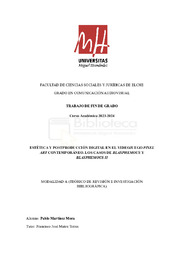Please use this identifier to cite or link to this item:
https://hdl.handle.net/11000/33450Full metadata record
| DC Field | Value | Language |
|---|---|---|
| dc.contributor.advisor | Mateu Torres, Francisco José | - |
| dc.contributor.author | Martínez Mora, Pablo | - |
| dc.contributor.other | Departamentos de la UMH::Ciencias Sociales y Humanas | es_ES |
| dc.date.accessioned | 2024-10-10T08:01:38Z | - |
| dc.date.available | 2024-10-10T08:01:38Z | - |
| dc.date.created | 2024-06 | - |
| dc.identifier.uri | https://hdl.handle.net/11000/33450 | - |
| dc.description.abstract | El videojuego es un medio de comunicación y expresión artística que ha experimentado una gran evolución desde sus orígenes hasta la actualidad. Uno de los aspectos que más ha cambiado es el de la representación gráfica, que ha pasado de ser una limitación técnica a ser una elección estilística, motivada probablemente por la nostalgia retro, por la apertura del mercado independiente o por las limitaciones técnicas de los dispositivos portátiles como smartphones o tablets. Dentro de las diversas formas de arte digital que existen en el videojuego, una de las más destacadas y populares es el Pixel Art, que consiste en editar imágenes a nivel del píxel, la mínima unidad de color que compone una imagen digital. El Pixel Art tiene una larga historia y una gran influencia en la cultura y la estética del videojuego retro, y sigue siendo utilizado por muchos creadores en la actualidad, tanto por motivos prácticos como conceptuales. En este trabajo se pretende analizar el uso y el significado del Pixel Art en el videojuego contemporáneo, tomando como casos de estudio dos obras españolas de gran éxito: Blasphemous (The Game Kitchen, 2019) y Blasphemous 2 (The Game Kitchen, 2023). | es_ES |
| dc.description.abstract | The video game is a medium of communication and artistic expression that has undergone significant evolution from its origins to the present day. One of the aspects that has changed the most is graphic representation, which has shifted from being a technical limitation to a stylistic choice, likely motivated by retro nostalgia, the opening of the independent market, or the technical limitations of portable devices such as smartphones or tablets. Among the various forms of digital art present in video games, one of the most notable and popular is Pixel Art, which involves editing images at the pixel level, the smallest unit of color that makes up a digital image. Pixel Art has a long history and a significant influence on the culture and aesthetics of retro video gaming, and it continues to be used by many creators today, both for practical and conceptual reasons. This work aims to analyze the use and significance of Pixel Art in contemporary video gaming, taking as case studies two highly successful Spanish works: Blasphemous (The Game Kitchen, 2019) and Blasphemous 2 (The Game Kitchen, 2023). | es_ES |
| dc.format | application/pdf | es_ES |
| dc.format.extent | 39 | es_ES |
| dc.language.iso | spa | es_ES |
| dc.publisher | Universidad Miguel Hernández de Elche | es_ES |
| dc.rights | info:eu-repo/semantics/openAccess | es_ES |
| dc.rights.uri | http://creativecommons.org/licenses/by-nc-nd/4.0/ | * |
| dc.subject | Contemporaneidad | es_ES |
| dc.subject | Nostalgia | es_ES |
| dc.subject | Arte digital | es_ES |
| dc.subject | PixelArt | es_ES |
| dc.subject | Estilismo retro | es_ES |
| dc.subject | Contemporaneity | es_ES |
| dc.subject | Nostalgia | es_ES |
| dc.subject | Digital art | es_ES |
| dc.subject | Retro styling | es_ES |
| dc.subject.other | CDU::7 - Bellas artes::77 - Fotografía. Cinematografía | es_ES |
| dc.title | Estética y postproducción digital en el videojuego Pixel art contemporáneo. Los casos de Blasphemous y Blasphemous II | es_ES |
| dc.type | info:eu-repo/semantics/bachelorThesis | es_ES |

View/Open:
CAU_TFG_MARTINEZ_MORA_PABLO.pdf
13,34 MB
Adobe PDF
Share:
.png)
